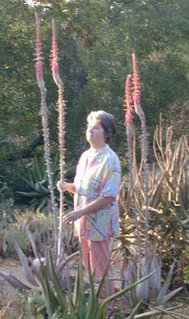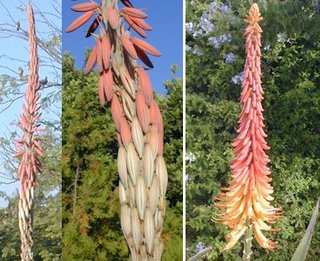Summertime blooms with small differences
Summer is not the best time for flowers in our aloe garden, as most South African aloes bloom in winter. It is only the small area down here in the Western Cape where the winter rainfall aloes bloom in summer. It is logical coming to think of it, flowering in summer result in seeds ready for the rain in winter and the opposite holds true for the summer rainfall aloes. However rainfall in the dry desert areas of Namibia is the mainly in summer but the aloes will bloom before or after winter if there was good rainfall, shifting the flowering times to make the most of the rain. Then there are the tropical aloes which blooms at least twice a year and some hybrids bloom twice a year too. I understand there are some aloe cultivators who aim to develop a hybrid aloe which will bloom the whole year round like many of our cultivated garden flowers.
In short - it is possible to have at least one of the aloe species (or hybrids) in bloom at any time throughout the year. That does not mean changing the watering times will change the flowering times, nature tuned the plants finer than that. The plants have a daylight length timer and temperature timer as well. Having said that, it is possible to manipulate water, light and temperature including hormones, but not for the normal garden.
My favourite in our garden at this time is Aloe comosa the single stem plant can grow up to 5 metres with an inflorescens (flower stalk) that grows around 2 meters . The inflorescens keeps growing as the flowers open. Note the size of the plants (the two blue plants at my feet) in contrast to those long flower stalks. These plants were cultivated from seeds and it is their second year in bloom.

The habitat of Aloe comosa is just about 100 km north of Moorreesburg so we do not have any problem growing this aloe. A. comosa is a single trunk aloe. The flowers are a pastel peach-pink shading to cream as they open. The plant is a very pale blue-green shading to pink in the summer sun. At this time the rosette is very dry, it seems that there can not be any strength left to survive, but it will - provided nobody waters it. This aloe has adapted to no rain in summer.
Aloe comosa in habitat. The stems alone are higher than I am - add to that the rosette and the very long inflorescens. It will be a long time for my plants to grow this size but that is not a problem as they bloom before they develop a stem.
By the way - This aloe makes a fine pot plant. As long as you can keep it out of the rain in summer. The contrast of the blue-pink rosette amongst other green plants makes an attractive display. Aloe comosa can withstand light frost.
Photo above is aloe comosa left and aloe africana right.
The blooms of Aloe comosa tip over from pointing upwards to hanging. Aloe comosa has a raceme more than 2x the length of the Aloe africana raceme. Aloe africana buds hang down right at the start and then the tips of each flower bends slightly upwards. The effect is completely different racemes.
Aloe africana is another lovely aloe blooming at this time in our garden. It should bloom July - September but it seems slightly confused by our climate. The habitat of Aloe africana is from the southern to the south eastern part of South Africa. It gets summer and winter rain, but before any-one from the rainy countries get excited,
no frost.

Photo is Aloe africana and the spade is to show size. From the distance it looks like "just a typical aloe", but it is a good looking typical aloe and it has a lovely infloroscens.
A habitat photo of Aloe africana does not show much. Everything is green and that is where this bright green aloe fits in. It is difficult to see on a photo but the whole hill is covered in Aloe africana unfortunately not in bloom at the time. Pity, but imagine it.
Below are the close-up photos of the flowers of Aloe comosa and Aloe africana. Aloe comosa has a raceme more than 2x the length of the Aloe africana raceme. The A.comosa buds point upwards then they tip over to hang pointing down in the end. Aloe africana buds tips over right at the start and then the tips of each flower bends slightly upwards. The effect is completely different racemes.















